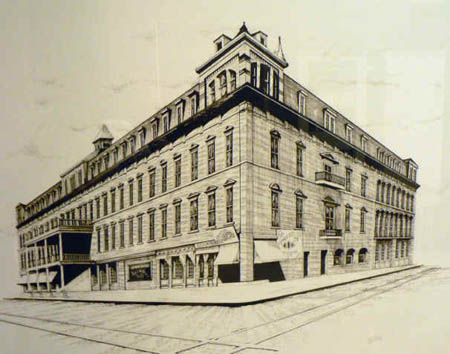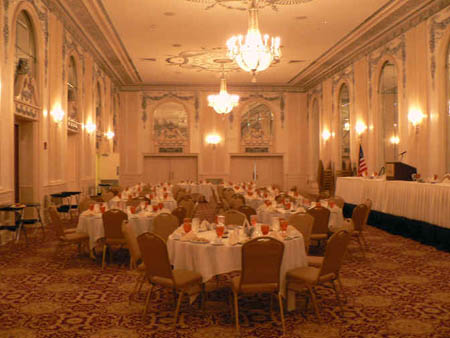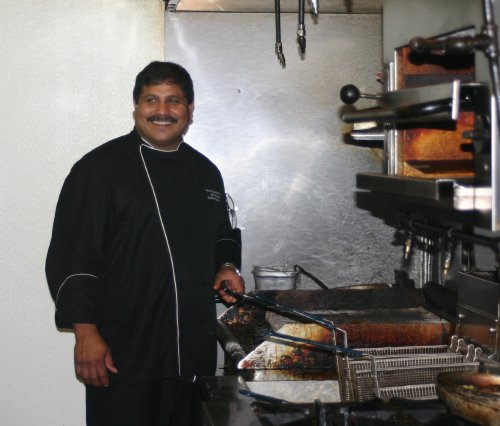|
Read House: A Part of Chattanooga's History
by Kathleen Walls
 The Old Crutchfield House from a print at Read Houses
Photo Martin Walls
New hotels come and go but one Grande Dame of the old guard, The Read House refuses to be outclassed. It combines modern convenience and history in such a subtle blend you will fall in love with the place. It's not what you expect from a chain hotel, no matter how prestigious.
The Sheraton Read House began life as the Crutchfield House in 1847. Chattanooga was just emerging as a railway hot spot. Thomas Crutchfield and his family built their inn directly across from the rail terminal, insuring the inn's success. The trains turned Chattanooga into a boomtown and the Cruchfields prospered.
----------
As the dark era of the Civil War began, things changed in Chattanooga and for the hotel. One historic event that took place in the hotel lobby reflected the times to come. Jefferson Davis was a guest at the hotel on his way home to Mississippi after resigning from the U.S. Senate, Davis spoke briefly and temperately on the subject of succession. But it was still enough to enflame William Crutchfield, Thomas's brother.. William called Davis a traitor and military despot. Davis demanded satisfaction. A duel was barely averted when Thomas Crutchfield, Jr. hurried his fiery brother out of sight. Some reports say Thomas was a Southern sympathizer. William and Thomas's differences were a microcosm of Chattanooga and the entire stare of Tennessee. It was deeply divided on this issue.
Some reports say William never enlisted but did act as an honorary captain in the Union Army at Chickamauga campaign and the siege of Chattanooga. However, Elizabeth Lyle Saxon, a relative of the Crutchfields, in her book published in 1905, stated: "Will Crutchfield, to whom I have before referred, was then a major on the Union General Wilder's staff and twenty-odd in number of his blood relations swept up in the gray-clad ranks of the Confederacy, to meet death. But he took no part in the hostilities after the first day, for the reason that he had a serious illness which lasted a week. Years after he learned that his wife, whose sympathies were as strong for the South as were his for the Union, had drugged him heavily, and so prevented his taking further part in the fratricidal strife. "
Whether it was due to the "house divided" or commercial reasons, Thomas Crutchfield sold the hotel shortly before the war. The new owners never prospered. When the fighting swept into Chattanooga, The hotel was commandeered by the Union forces and converted into a hospital in 1863. The hotel survived the entire war only to burn to the ground in 1867.
That might have been the end of the line for the hotel had not a doctor named John T. Read stepped into the picture. By 1871the city's economy had begun its slow recovery. Dr. Read and his son, Samuel, capitalized on this and built an even grander hotel on the old Crutchfield House site.
For the first time, the sign over the door was "Read House" the name by which it is still known. The doctor's son, Samuel, enhanced the hotel's reputation. The Read House became the place the elite chose to stay in Chattanooga.
In 1927 the original structure was replaced by the present 10-story Georgian style brick and terra cotta building. Those original materials would be far too costly to duplicate today: terrazzo floors inlaid with marble; paneling of quarter-sawed walnut, carved and gilded woodwork, mirrors recessed in massive arches and a lobby beautifully defined by its soaring columns. Fortunately most of these exquisite features survived the re-dos over the years. A few such as a large mahogany bar were lost to architect's whims.
 Silver Ballroom Photo Martin Walls
One priceless item was preserved by a small quirk of fate: during one of the later restorations, the contractor was redoing the Silver Ballroom on the second floor. It has a beautiful silver and crystal Waterford chandelier and some sconces that looked like wrought iron. The contractor ordered the sconces torn out as he thought they did not go with the "Silver" theme. A bellman, Howard Johnson, who had worked for the hotel for 27 years. Said, "No don't take them out". Polish them."
The sconces turned out to be solid silver when polished. Naturally, they still grace the ballroom today.
Of course you wouldn't expect anything to be ordinary in a place like the Read House and you would be right. It has played host to notables like Winston Churchill and Al Capone- fortunately not at the same time- Tallulah Bankhead, Gary Cooper and Tom Thumb. Dixie Carter and her husband, Hal Holbrook are frequent guests.
It even has its own resident ghost. Annalisa Netherly was a living breathing guest at the hotel in the late 20's when extended hotel stays were common. Not much is known of how she came to the Read House. Perhaps her husband brought her or perhaps it was a "gentleman friend" but however she arrived her spirit was destined to remain through the ages. Legend says that her husband found her romantically entertaining another man and was so enraged he slit her throat almost decapitating her in the bathtub of room 311. That's the room she is seen in most frequently.
She doesn't seem to like men, especially men who smoke. Ironically her room is on a smoking floor so that creates some interesting situations. Al Capone also stayed in that room as a "guest" of the government when he was brought to trail in Chattanooga. Talk about your original "odd couple".

Chef John Palacio in the kitchen of Porter's Steakhouse Photo Kathleen Walls |
Along with history, a ghost and marvelous decor, the hotel boast a wonderful dining room, Porter's Steakhouse. John Palacio, the executive chef, reigns supreme in his kitchen. Under his watchful eye, no steak shall arrive in the dining room unless it is cooked to perfection.
In 1977, the Read House was included in the National Register of Historic Places as a prime example of period architecture and decorative art.
The Crutchfields and Reeds would be very proud that their names are commemorated in this hotel.
For more information about the Read House, visit http://www.readhousehotel.com/
|